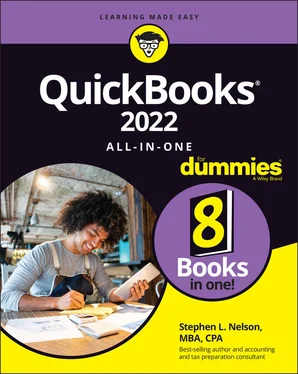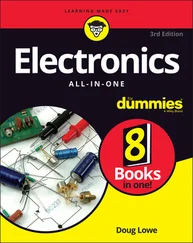You see where I am now, right? I’ve admitted that you can construct financial statements by using the fiddle-faddle method. But I hope I’ve also convinced you that the fiddle-faddle method suffers some really debilitating weaknesses. I’m talking about something as important as how you can best manage the financial affairs of your business. These weaknesses indicate that you need a better tool. Specifically, you need double-entry bookkeeping, which I discuss next.
How Double-Entry Bookkeeping Works
After you conclude that the fiddle-faddle method is for the birds, you’re ready to absorb the necessary accounting theory and learn the bookkeeping tricks required to employ double-entry bookkeeping. Essentially, you need two things to work with double-entry bookkeeping: an understanding of the accounting model and a grasp of the mechanics of debits and credits. Neither of these things is difficult. If you flip ahead a few pages, you can see that I’m going to spend only a few pages talking about this material. How difficult can anything be that can be described in just a few pages? Not very, right?
Here’s the first thing to understand and internalize to use double-entry bookkeeping: Modern accounting uses an accounting model that says assets equal liabilities plus owner’s equity. The following formula expresses this in a more conventional, algebraic form:
assets = liabilities + owner's equity
If you think about this for a moment and flip back to Table 2-2, you see that this formula summarizes the organization of a business’s balance sheet. Conceptually, the formula says that a business owns stuff and that the money or the funds for that stuff comes either from creditors (such as the bank or some vendor) or the owners (either in the form of original contributed capital or perhaps in reinvested profits). If you understand the balance sheet shown in Table 2-2and discussed here, you understand the first core principle of double-entry bookkeeping. This isn’t that tough so far, is it?
Here’s the second thing to understand about the basic accounting model: Revenue increases owner’s equity, and expenses decrease owner’s equity. Think about that for a minute. That makes intuitive sense. If you receive $1,000 in cash from a customer, you have $1,000 more in the business. If you write a $1,000 check to pay a bill, you have $1,000 less in the business.
Another way to say the same thing is that profits clearly add to owner’s equity. Profits get reinvested in the business and boost owner’s equity. Profits are calculated as the difference between revenue and expenses. If revenue exceeds expenses, profits exist.
Let me review where I am so far in this discussion about the basic accounting model. The basic model says that assets equal liabilities plus owner’s equity. In other words, the total assets of a firm equal the total of its liabilities and owner’s equity. Furthermore, revenue increases owner’s equity, and expenses decrease owner’s equity.
At this point, you don’t have to intuitively understand the logic of the accounting model and the way that revenue and expenses plug into the owner’s equity of the model. If you do get it, that’s great but not necessary. But you do need to memorize or remember (for at least the next few paragraphs) the manner in which the basic model works.
 This point may seem to be redundant, but note that a balance sheet is constructed by using information about a firm’s assets, liabilities, and owner’s equity. Similarly, note that a firm’s income statement is constructed by using information about its revenue and its expenses. All this discussion — all this tediousness — is really about how you collect the information necessary to produce an income statement and a balance sheet.
This point may seem to be redundant, but note that a balance sheet is constructed by using information about a firm’s assets, liabilities, and owner’s equity. Similarly, note that a firm’s income statement is constructed by using information about its revenue and its expenses. All this discussion — all this tediousness — is really about how you collect the information necessary to produce an income statement and a balance sheet.
Now I come to perhaps the most important point to understand to get double-entry bookkeeping. Every transaction and every economic event that occurs in the life of a firm produces two effects: an increase in some account shown in the balance sheet or income statement and a decrease in some account shown in the balance sheet or income statement. When something happens, economically speaking, that something affects at least two types of information shown in the financial statement. In the next few paragraphs, I give you some examples so that you can really understand this concept.
Suppose that in your business, you sell $1,000 worth of an item for $1,000 in cash. In the case of this transaction or economic event, two things occur from the perspective of your financial statements:
Your cash increases by $1,000.
Your sales revenue increases by $1,000.
Another way to say this same thing is that your $1,000 cash sale affects both your balance sheet (because cash increases) and your income statement (because sales revenue is earned).
See the duality? And just a paragraph ago, you were thinking that this topic might be too complicated for you, weren’t you?
Here’s another common example. Suppose that you buy $1,000 worth of inventory for cash. In this case, you decrease your cash balance by $1,000, but you increase your inventory balance by $1,000. Note that in this case, both effects of the transaction appear in sort of the same area of your financial statement: the list of assets. Nevertheless, this transaction also affects two accounts.
 When I use the word account, I simply mean some value that appears in your income statement or on your balance sheet. If you look at Tables 2-1and 2-2, for example, any value that appears in those financial statements that isn’t simply a calculation represents an account. In essence, an account tracks some group of assets, liabilities, owner’s equity, contributions, revenue, or expenses. I talk more about accounts in the next section, where I get to the actual mechanics of double-entry bookkeeping.
When I use the word account, I simply mean some value that appears in your income statement or on your balance sheet. If you look at Tables 2-1and 2-2, for example, any value that appears in those financial statements that isn’t simply a calculation represents an account. In essence, an account tracks some group of assets, liabilities, owner’s equity, contributions, revenue, or expenses. I talk more about accounts in the next section, where I get to the actual mechanics of double-entry bookkeeping.
Here’s another example that shows this duality of effects in an economic event. Suppose that you spend $1,000 in cash on advertising. In this case, this economic event reduces cash by $1,000 and increases the advertising expense amount by $1,000. This economic event affects both the assets portion of the balance sheet and the operating expenses portion of the income statement.
And now — believe it or not — you’re ready to see how the mechanics of double-entry bookkeeping work.
Roughly 500 years ago, an Italian monk named Luca Pacioli devised a systematic approach to keeping track of the increases and decreases in account balances. He said that increases in asset and expense accounts should be called debits, whereas decreases in asset and expense accounts should be called credits. He also said that increases in liabilities, owner’s equity, and revenue accounts should be called credits, whereas decreases in liabilities, owner’s equity, and revenue accounts should be called debits.
Table 2-3summarizes the information that I just shared. Unfortunately — and you can’t get around this fact — you need to memorize this table or dog-ear the page so that you can refer to it easily.
TABLE 2-3You Must Remember This
| Account |
Debit |
Credit |
| Assets |
Increase |
Decrease |
| Expenses |
Increase |
Decrease |
| Liabilities |
Decrease |
Increase |
| Owner’s equity |
Decrease |
Increase |
| Revenue |
Decrease |
Increase |
In Pacioli’s debits-and-credits system, any transaction can be described as a set of balancing debits and credits. This system not only works as financial shorthand, but also provides error checking. To get a better idea of how it works, look at some simple examples.
Читать дальше

 This point may seem to be redundant, but note that a balance sheet is constructed by using information about a firm’s assets, liabilities, and owner’s equity. Similarly, note that a firm’s income statement is constructed by using information about its revenue and its expenses. All this discussion — all this tediousness — is really about how you collect the information necessary to produce an income statement and a balance sheet.
This point may seem to be redundant, but note that a balance sheet is constructed by using information about a firm’s assets, liabilities, and owner’s equity. Similarly, note that a firm’s income statement is constructed by using information about its revenue and its expenses. All this discussion — all this tediousness — is really about how you collect the information necessary to produce an income statement and a balance sheet. When I use the word account, I simply mean some value that appears in your income statement or on your balance sheet. If you look at Tables 2-1and 2-2, for example, any value that appears in those financial statements that isn’t simply a calculation represents an account. In essence, an account tracks some group of assets, liabilities, owner’s equity, contributions, revenue, or expenses. I talk more about accounts in the next section, where I get to the actual mechanics of double-entry bookkeeping.
When I use the word account, I simply mean some value that appears in your income statement or on your balance sheet. If you look at Tables 2-1and 2-2, for example, any value that appears in those financial statements that isn’t simply a calculation represents an account. In essence, an account tracks some group of assets, liabilities, owner’s equity, contributions, revenue, or expenses. I talk more about accounts in the next section, where I get to the actual mechanics of double-entry bookkeeping.










